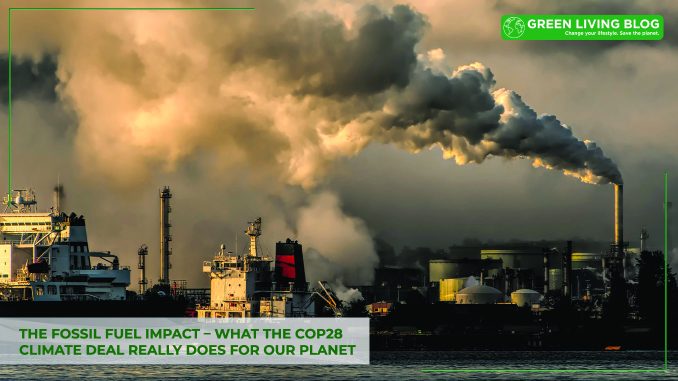
On the 30th of November, the World Meteorological Organization published a report on the global temperature averages.
The report is based on data from several organisations, including:
- National Oceanic and Atmospheric Administration (NOAA)
- The World Climate Research Programme
- The Global Atmosphere Watch
- The Global Cryosphere Watch
- Intergovernmental Oceanographic Commission – UNESCO (UNESCO-IOC)
- UN Environment Programme (UNEP)
- United Nations Office for Disaster Risk Reduction (UNDRR)
The report concluded that 2023 was the hottest year in recorded history. The fossil fuel impact was laid bare, in numbers.
It stated that the average global temperature was 1.4 degrees higher in 2023 than the pre-industrial average.
This report set the stage for COP28, which was due to begin the same day, November 30th.
The conference lasted for 13 days, ending on the 12th of December, but not before a landmark deal had been inked.
This landmark deal is being called ‘landmark’ because it acknowledges, for the first time, the immediate need to do something about the fossil fuel impact on climate.
The main conclusion of the deal was that emissions of ~25 GtCO2e (25 Gigatons Of Carbon Dioxide Equivalent) need to be reduced by 2030.
This reduction will keep the ‘North Star goal’ (temperature increase of no more than 1.5 degrees Celsius) on track.
COP28 was a significant milestone because of its location, its outcome, its timing, and above all, for acknowledging the need to reverse the fossil fuel impact on our planet’s climate.
The COP28 Climate Deal – 5 Key Agreements
The COP28 climate deal has no less than 14 action points, which are formally called “Key Negotiated Outcomes”.
These are available to read in this PDF (pages 8-11) from the official COP28 website.
The deal took stock of the progress since the Paris Agreement and repositioned the “desired outcomes” accordingly.
There are five key negotiated outcomes that stand out in the COP28 deal.
Each of them will have a major impact on the way participating countries handle climate change, and we will explore each of them below.
1. Agreement To Fight Fossil Fuel Impact
View this post on Instagram
The key outcome of the COP28 climate deal was the formal recognition of fossil fuel impacts and the need to oust them.
In over three decades of climate negotiations, this was the first time that this transition has been explicitly mentioned, and not implied.
The COP28 climate deal was also the first time that the words “fossil fuels” have been mentioned in a COP outcome.
There was aggressive lobbying from the United States and the EU for the transition and strong opposition from the oil and gas sector.
In the end, it was agreed that the fossil fuel impact is real, and so is the need to transition away from carbon-based fuels in a ‘just, orderly, and equitable manner”.
You can read the relevant clause about what’s to be done about fossil fuel impact and transitioning away from carbon-based fuels in this UNFCCC document (Clause 28, sub-clause “d”).
2. Aggressive Shift Towards Renewable Energy
View this post on Instagram
While the decision to phase away carbon-based fuels, to combat fossil fuel impact, is the biggest outcome, there’s more to it.
The COP28 climate deal also calls on parties to triple their renewable energy capacity by 2030.
At the same time, the goal is to double the energy efficiency of existing energy systems.
This is a part of the “Global Renewables And Energy Efficiency Pledge”.
This particular pledge was endorsed by 116 countries, with the notable exception of India, China, and Russia, three of the top carbon emitters.
This is likely to mark a notable increase in the sustainable energy sector and should provide a few jobs to the economies of participating countries.
As a part of this move, several countries (22) advocated for a tripling in nuclear energy as well.
Nuclear energy is seen as clean, but not renewable because of the long life of its waste by-products.
The main proponents for the ‘nuclear tripling’ were the UK, the US, Canada, Japan, and France.
You can find all the relevant details in this UNFCCC summary document (Clause III).
3. The Zero Methane Emissions Commitment
The COP28 deal included the creation of the “Oil And Gas Decarbonization Charter”. As part of the charter, the global methane reduction target was announced as 30%.
To aid that target, 50 of the world’s top oil and gas companies signed the deal, committing to flat zero methane emissions on their part by 2030.
Notably, these 50 companies together account for over 40% of global oil production and are responsible for a major part of the fossil fuel impact on the planet’s climate.
To help the move, the World Bank has created the GFMR partnership, of $250 Million (£ 197 Million).
GFMR stands for “Global Flaring And Methane Reduction”, and is set to help aid methane emission science.
Notably, many major players (Chevron, Exxon, ENOC) are not currently contributing to the fund.
4. The Creation Of A “Loss And Damage” Fund
View this post on Instagram
COP 27, held at Sharm El-Sheikh in Egypt last year, had advocated for the creation of a “Loss And Damage” fund.
The fund was created through paragraph 3 of decisions 2.CP.27 and 2.CMA.4 at COP 27.
The main goal of this fund would be to provide financial assistance to economically weaker nations to deal with the “unavoidable impacts of climate change”.
At COP28, this fund was finally operationalized and logged contributions by more than 50 UNFCCC member parties.
The fund was operationalized through paragraphs 2 & 3 of decisions 2.CP.28 and 2.CMA.5 at COP28.
All in all, the COP28 climate deal L&D fund has secured $792 Million (£622 Million) in funding.
Note – that the confirmed figure is at the time of writing, UNFCCC parties have until next year to declare their contribution amount.
5. A Declaration On Food Systems
Analysis: COP28 put food system transformation on the menu, but who will pick up the bill? @tslavinm talks to @DianeBHoldorf @morgan_gillespy @pattyfong17 Carlos Nobre Juliana Lopes Amaggi #regenag #SaveSoilMovement @wbcsd @FOLUCoalition @REvents_SustBiz https://t.co/8MrvNLeLnG
— Reuters Events Sustainable Business (@REvents_SustBiz) December 22, 2023
For another first in COP history, 134 countries signed the COP28 declaration of food systems.
The declaration addresses and recognizes the impact of climate change on food security and food systems around the world.
As part of the declaration negotiations, the main examples used were those of Sri Lanka and Lebanon.
The COP28 climate deal food systems declaration calls for parties to include it in their national policies.
It also includes “support for innovation and technology”, and ‘financial and technical support” for emerging nations.
The declaration is called “Transforming Our Food Systems: The Race To Resilience”.
Will The COP28 Climate Deal Impact Climate Change? – 5 Key Challenges
The COP28 climate deal is marked by several ambitious agreements, five of which have been explained above.
The deal is also an action plan and suggests several measures on how to achieve those ambitious goals.
However, experts have called the deal “a disappointing win”, “grossly insufficient” and “watered-down”.
This begs the question, how effective is the COP28 climate deal? Below, we look at the biggest challenges that may impact the effectiveness of the deal.
1. The Carbon Fuel Phase Out Has Left Loopholes For Fossil Fuel Companies
View this post on Instagram
The mission statement of the phase-out is the “rapid transition from carbon-based fuels” (to renewable sources).
However, the COP28 climate deal has left two major loopholes for oil and gas corporations.
- Transitional Fuels
The COP28 climate deal advocates a lot of support for “transitional fuels”. These are fuels that are less polluting than oil, but not renewable.
In this regard, “transitional” fuels are often interpreted as natural gas, liquefied petroleum, and compressed natural gas.
- CCS Technology
CCS stands for Carbon capture and storage. The COP28 climate deal has not talked about the restrictions of CCS technology, which is not seen as an effective way to combat climate change. The money being spent on CCS technology could be well utilised elsewhere.
These moves have raised concerns that they could undermine the goal of a rapid transition away from fossil fuels.
2. Renewable Energy Systems Need Significant Investment
View this post on Instagram
Of course, the move away from carbon-based fossil fuels is a cornerstone of the COP28 climate deal. It is not without its challenges, however.
Fossil fuels are a lot more economical than their renewable counterparts to produce, distribute, and use.
That is one of the key reasons why renewable energy sources are more accessible in developed economies.
The deal has not addressed this substantial investment needed, which will heavily affect the budget of developing nations.
The North Star goal is equally distributed, and the carbon reduction goal is equally distributed, but the financial burden cannot be equally distributed.
A small island nation will not be able to commit the same amount of renewable energy investment as the United States or France, for example.
The COP28 climate deal has completely failed to address or even acknowledge this situation, leading to criticism.
3. Emissions From Fuel Consumption Remain A Major Concern
A fairly critical gap in the COP28 climate deal is the failure to address the end-users of fossil fuels.
The deal mainly focuses on limiting the production (source) of fossil fuels. It fails to address the (huge) emissions created by the use of the existing fuels.
This would include motor vehicles, electricity generation, the shipping industry, aviation, etc.
This means that a significant part of the climate impact from the fossil fuel industry remains unaddressed until the world moves completely to renewable energy sources.
This gap could undermine the efforts to reduce greenhouse gases and meet the North Star goal of 1.5 degrees Celsius.
4. Lack Of Detail In The Loss And Damage Fund Policy
Environmental expert @S_Maryam8 & @harjeet11, Head of Global Political Strategy at Climate Action Network International, analyze key #COP28 outcomes. They highlight the operationalization of the Loss & Damage Fund on day one but note flaws in fossil fuel transition language, &… pic.twitter.com/rl3KqBplN5
— New Wave Global (@NewWaveGlobal_) December 23, 2023
The operationalization of the L&F fund is a very positive step, but it is not without shortcomings.
Foremost, the damage caused by climate change each year is estimated to cost between $100 billion and $400 billion (£79 billion – £315 billion).
Also, there has been no policy created on how the funds will be distributed, recovered, or used once disbursed.
The L&F fund has said that it is for “fiscally developing and economically weaker” nations, but that is about the most detail that we get.
There are no measures for equal distribution of the total funds raised, no mention of any reserve requirements, no mention of repayment requirements, and no mention of use guidelines.
5. Question Marks on Policy Integration Of Sustainable Food Systems
COP28 has stressed the urgent need to accelerate the transition to a future-fit #FoodSystem that produces healthy & #SustainableFood for all. 🌱🌍
How is the #FoodIndustry working together to achieve a #NetZero food system? 🤝🍽️
Read more in our blog 🔗 https://t.co/zqABLPUfyI pic.twitter.com/Hg32qr6vCC
— EIT Food (@EITFood) December 22, 2023
The declaration on food security is mostly about introducing sustainable agricultural practices.
However, the success of this initiative is dependent on the cooperation of all involved parties.
The move towards sustainable agriculture would require consistent monitoring and compliance with commitments.
Critically, involved countries will need to include the points from the declaration in their national policies, which may not be possible for another few years.
Achieving the goals in the declaration will require substantial financial support, technology overhauls, and policy reforms.
For agrarian economies like India, Sri Lanka, and most of Africa, this move may not be possible rapidly because of the impact on the economy.
The COP28 climate deal has not considered this challenge with respect to the economic impact of more expensive food systems.
More Hope Than Despair
View this post on Instagram
The COP28 climate deal is quite an advancement in tackling climate change and is quite impressive in that regard.
However, it has yet to stand the test of time, and it will have to face a number of significant challenges to leave any meaningful impact.
The success of the COP28 deal will depend on how the global community responds to these challenges and keeps up with its commitments.
Ultimately, the COP28 deal will be defined not by the promises made, but by the actions taken and the collective resolve to turn these ambitious goals into tangible, global achievements.
![]()
Author Profile
- Online Media & PR Strategist
- Blogger and Educator by Passion | Senior Online Media & PR Strategist at ClickDo Ltd. | Fascinated to Write Lifestyle Blogs in News & Education I have completed a journalism summer course at the London School of Journalism and manage various blogs.
Latest entries
 Green GuidesMay 29, 202519 Best Eco-Friendly Products, Services & Gifts – With Special Deals
Green GuidesMay 29, 202519 Best Eco-Friendly Products, Services & Gifts – With Special Deals List postMay 28, 202510 Everyday Items with PFAs (‘Forever Chemicals’) and Green Alternatives
List postMay 28, 202510 Everyday Items with PFAs (‘Forever Chemicals’) and Green Alternatives List postMay 22, 20258 Eco-Friendly & Energy-Saving Home Gadgets for Daily Routines
List postMay 22, 20258 Eco-Friendly & Energy-Saving Home Gadgets for Daily Routines Green LivingMay 15, 20258 Healthy BBQ Swaps for a Cleaner, Greener, Guilt-free Grillfest
Green LivingMay 15, 20258 Healthy BBQ Swaps for a Cleaner, Greener, Guilt-free Grillfest






Leave a Reply
You must be logged in to post a comment.